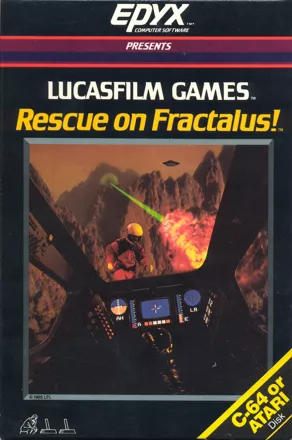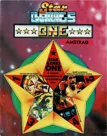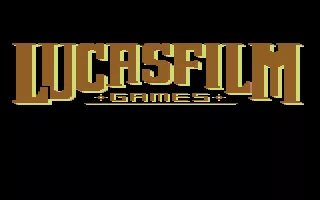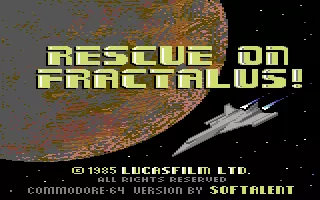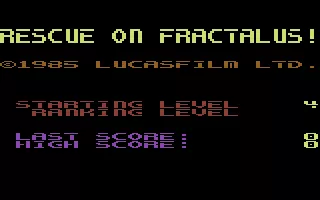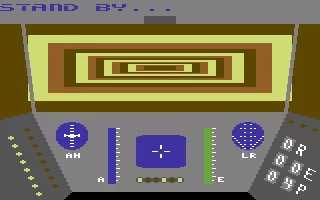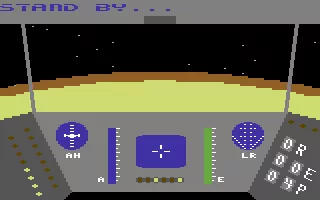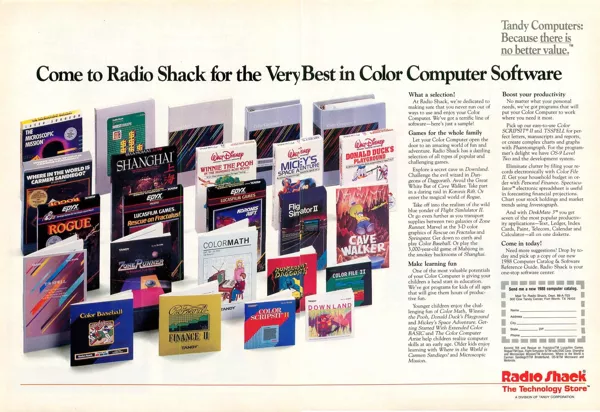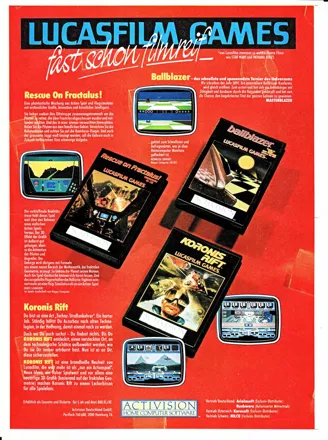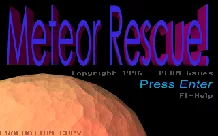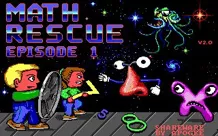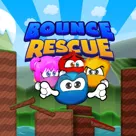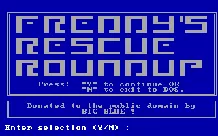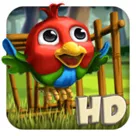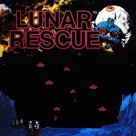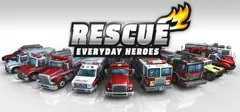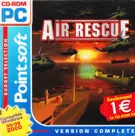Rescue on Fractalus!
Description official descriptions
Rescue on Fractalus! is an action game played from a 3D first person point of view. Your mission is to rescue stranded pilots on the planet of Fractalus. You begin each mission from the mother ship, and when your quota of pilots has been rescued you must return there so you can move on to the next level. To help locate the pilots and navigate the tricky terrain, your spaceship is equipped with various instruments, such as a compass, altimeter, and scanner.
Your enemy, the Jaggi's, have numerous forces on this planet and will be attempting to stop you. Gun emplacements, flying saucers, and the Jaggi themselves are all capable of destroying your ship if you don't destroy them first. To defend yourself from these threats, your ship is equipped with torpedoes. As the levels progress, the Jaggi defenses become more aggressive, and you will even need to fly some night missions where visibility is limited.
Screenshots
Promos
Credits (Apple II version)
| Programmer |
Reviews
Critics
Average score: 73% (based on 15 ratings)
Players
Average score: 3.6 out of 5 (based on 20 ratings with 1 reviews)
The Good
Rescue on Fractalus is one of those games that I played as a young lad on my beloved Atari 800XL. I spent numerous nights and days during the 80s (and 90s!) playing this game, and have gotten my fair share of entertainment out of it. While this means that I do have sentimental ties to the game, it does have a lot of really neat features under the hood.
First off, I really have to say that the graphics for this game are truly outstanding for the time. It has height-mapped terrain (and not that pseudo 3D stuff you see in late 80s/early 90s efforts like LHX Attack Helicopter or even LucasArts own Secret Weapons of the Luftwaffe), generated using the same engine used in the game Koronis Rift - another good title from LucasArts made during the same period. And that engine is FAST, running full tilt on the hardware of the time without missing a beat or with any weird artifacts or instances of clipping popping up. True, the resolution is a bit wanting (especially on the sprites), but you really can't ask for too much from something released in 1985.
The cinematics are also quite good. Again, the resolution is a bit low, but they are quite well animated and have an impressive color palette available to them. I really have to highlight the takeoff/atmospheric entry sequence - really one of the best sequences I've seen in a 80s game, with a real feeling of speed to it.
All these great graphics mean nothing without gameplay, however. And Rescue is an excellent game. Its sort of an action-arcade/flight simulator, with all the features as such as that would entail. You fly around and take out gun emplacements and enemy flying saucers, but the only way to pass a mission is to rescue downed pilots (hence the name of the game).
This entails landing on the planet's surface near the downed craft, turning off your shields and opening your airlock so that the pilot can hitch a lift back to the mothership. Most of the time this pilot is a normal one who gives you some additional fuel and points, but sometimes you get a high-scoring ace pilot. You also have to deal with the occasional disguised alien as well, so you have to search around a bit and find a spot that allows you to get a clear view of the pilot as he comes towards you. If he has a green helmet, up go your shields and away goes bug-eyes. Of course, you can also choose to vaporize innocent pilots this way too. Or you can just leave your hatch closed and let them dissolve in the acidic atmosphere of the planet if you are in a really sadistic mood. Rescue has quite a number of small details like that, which makes it immensely enjoyable for quite a long while. Even the planetary environment changes so as to allow you to do missions with fluctuating times of day (including at night) after a certain point.
The sound is also worthy of note. While there is only one song in this game, it’s pretty good and doesn't play all the time so it doesn't get annoying. In game, you get the standard assortment jet noises, shield and weapon noises and so on. However, since there's all this multichannel-sounding stuff going on, it sounds a bit more realistic than many of the other games of the era. I really don't think that there are more than two channels though, but it sounds like they have three or four going at the same time in some spots. Most impressive.
I also want to get to the manual for a second. It's the size of an NES manual, but it has a load more personality. I'm usually not really impressed with many manuals, but this is the exception. The layout of it is one of the best I've seen. It’s colorful, but not annoyingly so. It’s got the right amount of artwork and photographs. It uses a nice font that doesn't make blood shoot out of your eyes. Aside from instructions and the plot, it also has a bit of fiction and a technical break down of you fighter craft. Someone even built a model of it and had it professionally photographed, making appear as though it was full-sized. See if you can find that detail these days!
The Bad
It gets a little repetitive after awhile, and I'm not sure if there is an ending or not. This is a very minor quibble, though, considering the release date and the genre.
You know, it might be due to sentiment, but I really cannot find anything to seriously complain about in regards to this particular game. In fact, I'm surprised that LucasArts didn't bother to do a sequel to this one.
The Bottom Line
Again, I have to apologize for the gushing review here, but I really have to shoot straight with you in saying that I think this is a AAA-grade game here. If you can get a copy and find some way to run it, you are in for a real treat.
Atari 8-bit · by Longwalker (723) · 2007
Trivia
Cancelled ports
There were plans to port this game to the Atari 7800. A prototype was started but it was never completed or released.
Credits
Rescue comes from the time when Atari would not allow game developers to have credit in their games, so like many games of that era credits were hidden inside the game. Typing "author" on the title screen of the Atari 800 version would display "BY D.FOX L.CARPENTER C.KELLNER P.LANGSTON" on the bottom of the screen. The manual describes the Jaggi as coming from the Tepdi Vad Neroleil Rahcre star system, which, reversed and shifted over two letters, reads Charlie Loren David Peter. Finally, the symbols on the shirt of the alien Jaggis are the letters LC DF CK PL, the initials of the team, rotated 90 degrees counterclockwise.
Development
According to designer David Fox, the game was originally meant to be set in the Star Wars universe. However, Lucasfilm Ltd. did not allow this because at the time the real money was earned with licensing fees. Also the first prototype of the game did not feature a fire button because of Fox's pacifist attitude. It was added after a meeting with George Lucas during which he asked if the fire button is missing because of gameplay or philosophical reasoning.
Graphics
As the name suggests, this game uses a fractal generator to render the mountains. The use of fractals was suggested by Loren Carpenter. Carpenter was not actually part of the game development team but had previously worked on computer graphics used in films such as Return of the Jedi.
Jaggis
The name of the alien menace, the Jaggi, is derived from a rivalry between the Lucasfilm Games and Lucasfilm Computer divisions. The term "jaggies" refers to the visible pixels on the edges of objects that are most prominent on low resolution displays. Since Lucasfilm Computer were working with high tech rendering computers, and millions of colors, they could blend the colors of an object and the background with anti-aliasing, making the individual pixels less noticeable and removing jaggies. Lucasfilm Games, working on the Atari 800, had only four colors at their disposal, which made anti-aliasing impossible. Therefore they named the aliens Jaggi, because that was the only way they could destroy jaggies in the game.
Lucasfilm
Rescue on Fractalus! along with Ballblazer were the first games developed by Lucasfilm Games.
Piracy
Rescue was released to software piracy circles months before the game's release. According to David Fox the leak came from somewhere in Atari, because their near-final beta version of the game was mailed to Atari on a disk with no copy-protection.
Awards
- ACE (Advanced Computer Entertainment)
- March 1991 (issue #42) - Included in the list Greatest Games of all Time in category Original Games (editorial staff choice)
- Commodore Format
- May 1991 (Issue 8) - listed in the A to Z of Classic Games article (Great)
- Computer Gaming World
- November 1996 (15th anniversary issue) - #82 on the “150 Best Games of All Time” list
Information also contributed by LepricahnsGold, Pat Cdr and PCGamer77
Analytics
Upgrade to MobyPro to view research rankings and price history! (when applicable)
Related Sites +
-
30 Years Later: Lucasfilm’s Fractalus Revisited (November 7, 2015)
Obi-Wandi article -
The Making of Rescue on Fractalus! (November 2007)
Retro Gamer Issue 44 article
Identifiers +
Contribute
Are you familiar with this game? Help document and preserve this entry in video game history! If your contribution is approved, you will earn points and be credited as a contributor.
Contributors to this Entry
Game added by Servo.
ZX Spectrum, TRS-80 CoCo added by Kabushi. Amstrad CPC added by Martin Smith. Atari 8-bit added by Terok Nor.
Additional contributors: Kasey Chang, David Fox, karttu, Pseudo_Intellectual, Cantillon, Patrick Bregger, Lain Crowley, Jo ST, FatherJack, 64er.
Game added January 17, 2004. Last modified January 23, 2025.


